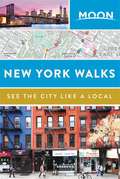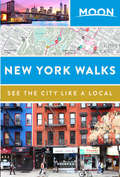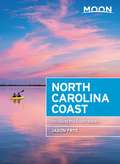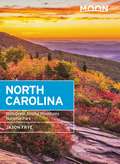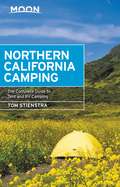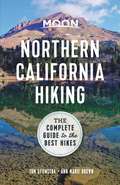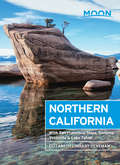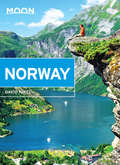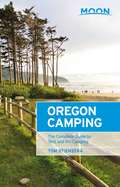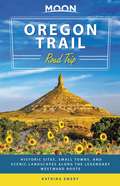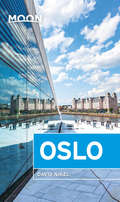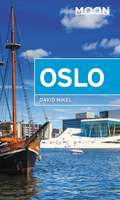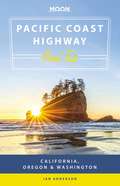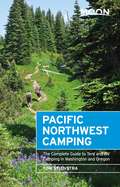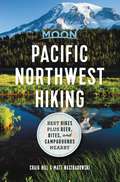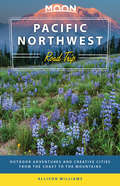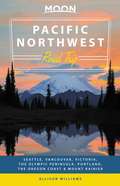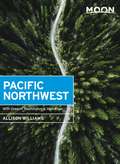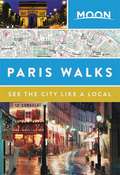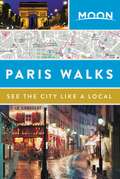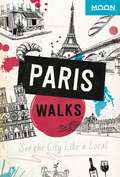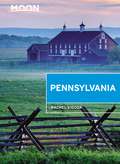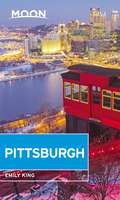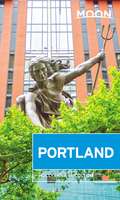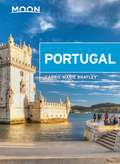- Table View
- List View
Moon New York Walks
by Moon Travel GuidesExperience the Big Apple like a local: on foot!Moon New York Walks guides you to the trendiest restaurants, buzzworthy boutiques, and iconic landmarks of New York City's can't-miss neighborhoods. This full-color guide to "the city that never sleeps" features:Six customizable walks through the city's hippest neighborhoods, including Soho, the West Village, the Lower East Side, Williamsburg, and more, with color-coded stops and turn-by-turn directionsFoldout maps of each route and a removable full-city map, in a handy, portable guideCurated "Top Ten" lists for dining, arts and culture, nightlife, and (of course) coffee, for visitors looking to hit the highlightsThe top attractions and the best-kept local secrets: Stroll down Fifth Avenue past icons like the Flatiron, the Empire State Building, and Rockefeller Centre, or walk along the Hudson River and learn the history of jazz and the Harlem Renaissance. Take in jaw-dropping views along the High Line, shop for trendy trinkets in the Meatpacking District, and explore world-famous galleries and museums. Cross the Williamsburg Bridge, peruse a flea market, and discover hip coffee shops tucked among the Brooklyn warehouses. Sample authentic dumplings in Chinatown, old-school deli standbys, or healthy vegan treats. Sip craft cocktails in an underground speakeasy, or admire the city skyline from a rooftop barPublic transportation options, including the subway, bus, taxi, or bike rentalTips for first-time visitors, including seasonal festivals, where you'll need to make a reservation, and getting to and from the airportWith creative routes, public transit options, and a full-city map, you can explore New York at your own pace, without missing a beat.Check out our guides to more of the world's liveliest cities, so you can hit the ground running! Also available: Moon Barcelona Walks, Moon Berlin Walks, Moon London Walks, Moon Amsterdam Walks, Moon Paris Walks, and Moon Rome Walks
Moon New York Walks (Travel Guide)
by Moon Travel GuidesExperience the Big Apple like a local: on foot!Moon New York Walks guides you to the trendiest restaurants, buzzworthy boutiques, and iconic landmarks of New York City's can't-miss neighborhoods. This full-color guide to "the city that never sleeps" features:Six customizable walks through the city's hippest neighborhoods, including Soho, the West Village, the Lower East Side, Williamsburg, and more, with color-coded stops and turn-by-turn directionsFoldout maps of each route and a removable full-city map, in a handy, portable guideCurated "Top Ten" lists for dining, arts and culture, nightlife, and (of course) coffee, for visitors looking to hit the highlightsThe top attractions and the best-kept local secrets: Stroll down Fifth Avenue past icons like the Flatiron, the Empire State Building, and Rockefeller Centre, or walk along the Hudson River and learn the history of jazz and the Harlem Renaissance. Take in jaw-dropping views along the High Line, shop for trendy trinkets in the Meatpacking District, and explore world-famous galleries and museums. Cross the Williamsburg Bridge, peruse a flea market, and discover hip coffee shops tucked among the Brooklyn warehouses. Sample authentic dumplings in Chinatown, old-school deli standbys, or healthy vegan treats. Sip craft cocktails in an underground speakeasy, or admire the city skyline from a rooftop barPublic transportation options, including the subway, bus, taxi, or bike rentalTips for first-time visitors, including seasonal festivals, where you'll need to make a reservation, and getting to and from the airportWith creative routes, public transit options, and a full-city map, you can explore New York at your own pace, without missing a beat.Check out our guides to more of the world's liveliest cities, so you can hit the ground running! Also available: Moon Barcelona Walks, Moon Berlin Walks, Moon London Walks, Moon Amsterdam Walks, Moon Paris Walks, and Moon Rome Walks
Moon North Carolina Coast: With the Outer Banks (Travel Guide)
by Jason FryeSalty air and the promise of adventure: answer the call of the ocean with Moon North Carolina Coast. Inside you'll find:Strategic itineraries, from a weekend getaway to the Outer Banks to a week covering the whole coast, designed for beach bums, outdoor adventurers, history buffs, families, and moreThe top sights and unique experiences: Visit the North Carolina Aquarium, explore a Civil War fort, discover the remains of sunken pirate ships, or climb to the top of a historic lighthouse. Order the catch of the day at a local fish shack, sample fresh oysters, or indulge in some authentic North Carolina barbecue. Relax on a sandy beach, spot wild horses on the shore, and watch the sun set over the glittering AtlanticOutdoor adventures: Kayak through misty marshes, take a moonlight paddling tour of a wildlife refuge, surf the powerful swells, or hike the largest sand dune on the East CoastThe best beaches for your trip, with lists of the top spots for sunbathing, water sports, wildlife viewing, solitude, and moreHonest insight from North Carolina local Jason Frye on when to go, where to eat, and where to stay, from rugged campgrounds to historic innsFull-color photos and detailed maps throughoutThorough background on North Carolina's culture, environment, wildlife, and historyWith Moon North Carolina Coast's diverse activities and local perspective, you can plan your trip your way.Exploring inland? Check out Moon North Carolina. Hitting the road? Try Blue Ridge Parkway Road Trip.
Moon North Carolina: With Great Smoky Mountains National Park (Travel Guide)
by Jason FryeFrom the Outer Banks to Asheville, discover the best of the Tar Heel State with Moon North Carolina. Inside you'll find:Flexible itineraries, including scenic drives along the Blue Ridge Parkway, a weekend in Great Smoky Mountains National Park, and getaways to Asheville, Raleigh-Durham, and CharlotteStrategic advice designed for hikers, beach-goers, foodies, wildlife-watchers, and moreThe top local experiences: Explore the gardens of the Biltmore Estate, check out the art museum in Raleigh, or kick back with a craft beer at an outdoor concert in Wilmington. Escape to the Outer Banks for a glimpse of wild horses, historic lighthouses, and remote islands. Tap your foot to live bluegrass and dig in to famous North Carolina barbecueOutdoor activities: Hike to waterfalls or challenge yourself to climb the highest peaks in Great Smoky Mountains National Park. Kayak around Kitty Hawk, whitewater raft in the wild Nantahala River Gorge, hang glide, or spend a day fly-fishingExpert tips from North Carolina local Jason Frye on when to go, how to get around, and where to stay, from rugged campgrounds to historic inns and beachside B&Bs Full-color photos and detailed maps throughout Thorough background on the landscape, climate, wildlife, and local cultureWith Moon North Carolina's expert advice and local insight, you can find your adventure.Focusing on the mountains? Check out Moon Asheville & the Great Smoky Mountains. Can't get enough of the beach? Try Moon North Carolina Coast.
Moon Northern California Camping: The Complete Guide to Tent and RV Camping (Moon Handbooks)
by Tom StienstraWhether you're camping among towering redwoods, along rugged coastline, or in the High Sierra, you'll always find your perfect campsite with Moon Northern California Camping.A Campsite for Everyone: Pick the right tent or RV site with options ranging from secluded Sierra hike-ins to convenient roadside stopovers, including dog-friendly, family-friendly, and wheelchair accessible options, and strategic lists of the best campgrounds for hiking, swimming, and moreRatings and Essentials: All campgrounds are rated on a scenic scale and marked with amenities like restrooms, trailhead access, picnic areas, laundry, piped water, showers, and playgroundsRecreation Highlights: Discover nearby hiking, swimming, fishing, biking, water-skiing, white water rafting, and hot springsMaps and Directions: Easy-to-use maps and detailed driving directions for each campgroundSkip the Crowds: Moon Northern California Camping contains many secluded spots and campgrounds that aren't available in the state's online reservation systemTrailhead Access Campgrounds: Find sites that offer access to the John Muir Trail, the Pacific Crest Trail, and more, plus essential information on hikingExpert Advice: Expert outdoorsman Tom Stienstra knows his stuff; he's hiked 25,000 miles in and around these campgrounds for over 30 yearsTips and Tools: Information on equipment, food and cooking, first aid, and insect protection, plus background on the climate, landscape, and history of the campsitesWhether you're a veteran or a first-time camper, Moon's comprehensive coverage and local insight will have you gearing up for your next adventure.Exploring more of the Golden State? Try Moon California Camping. Looking for some focused advice on outdoor recreation? Check out Moon California Hiking.
Moon Northern California Hiking: The Complete Guide to the Best Hikes (Moon Outdoors)
by Ann Marie Brown Tom StienstraPack a lunch, lace up your boots, and head out to discover the best hiking trails in NorCal with Moon Northern California Hiking.A Hike for Everyone: Pick the right hike for you, from breathtaking coastal walks to challenging backcountry treks, with options ranging from easy day hikes to multi-day backpacking tripsBest Hikes Lists: Choose from strategic lists like the best hikes for majestic redwoods, bird-watching, refreshing swimming holes, wheelchair accessibility and moreEssential Planning Details: Each hike is marked with round-trip distance and hiking time and rated for scenic beauty and trail difficultyMaps and Directions: Find easy-to-use maps, driving directions to each trailhead, and details on where to parkSkip the Crowds: Have the trail to yourself with Moon Northern California Hiking's many off-the-radar hikesExpert Advice: Seasoned hikers Tom Stienstra and Ann Marie Brown offer their experienced insight and honest opinions on each trailTips and Tools: Advice on gear, first aid, ethical hiking, and camping permits, plus background information on climate, landscape, and wildlifeWhether you're a veteran or a first-time hiker, Moon's comprehensive coverage and honest expertise will have you gearing up for your next adventure.Exploring more of the Golden State? Try Moon California Hiking. Hitting the road? Check out Moon California Road Trip.
Moon Northern California: With San Francisco, Napa, Sonoma, Yosemite & Lake Tahoe (Travel Guide)
by Elizabeth Linhart VenemanImmerse yourself in NorCal's diverse cities, quaint historic towns, towering forests, and stunning coastline with Moon Northern California. Inside you'll find:Strategic, flexible itineraries from three days in San Francisco to two days in Yosemite, designed for road trippers, outdoor adventurers, culture mavens, foodies, and moreHow to plan a Northern California road trip, with detailed mileage and driving times for trips to the North Coast, Shasta and Lassen, and the Gold CountryUnique experiences and can't-miss highlights: Explore a Gold Rush-era ghost town, stroll the Santa Cruz Beach Boardwalk, or crest San Francisco's steep hills on a historic cable car. Visit the Bay Area's world-class museums, learn something new at the Capitol Building in Sacramento, or watch the otters play at the Monterey Bay Aquarium. Climb Yosemite's granite peaks, hike among the redwoods in Sequoia and Kings Canyon, ski Tahoe's pristine powdery slopes, or catch a peek of the condors in Big Sur. Sample reds, whites, and rosés in wine country, savor an authentic Mission burrito, or enjoy a romantic dinner of fresh seafood as the sun sets over the PacificExpert advice from NorCal native Elizabeth Linhart Veneman on where to stay, where to eat, and how get around Full-color photos and detailed maps throughoutHandy tips for LGBTQ visitors, international travelers, families with children, seniors, and travelers with disabilitiesBackground information on the landscape, wildlife, history, and cultureFull coverage of San Francisco and the Bay Area, Wine Country, the North Coast, Shasta and Lassen, Lake Tahoe, Sacramento and Gold Country, Yosemite and the Eastern Sierra, the Central Coast, and Sequoia and Kings CanyonWith Moon Northern California's practical tips and local insight, you can plan your trip your way.Exploring more of the Golden State? Check out Moon California or Moon California Road Trip. For an epic outdoor adventure, pick up Moon California Camping or Moon Yosemite, Sequoia & Kings Canyon.
Moon Norway (Travel Guide)
by David NikelMoon Travel Guides: Your World Your WayExperience magnificent fjords, historical cities, and magical northern lights with Moon Norway.Inside you'll find:Flexible, strategic itineraries for every timeline and budget, from a week of the highlights to a three-week adventure through the whole countryFull-color photos and detailed maps throughoutCurated advice for outdoor adventurers, history buffs, culture mavens, road-trippers, and moreMust-see attractions and off-beat ideas for making the most of your trip: Find the best photo ops to capture Geirangerfjord's slender waterfalls, or hike to soaring cliffs overlooking glistening glacial lakes. Hope in the car and drive over islets and skerries on the Atlantic Road, or take a scenic train ride overlooking mountains, valleys, and fjords. Explore historic mountain towns, or wander small fishing villages along Norway's dramatic coastline. Admire world-class architecture and art in Oslo's cosmopolitan hub, or see the impressive restored vessels at the Viking Ship Museum. Sample fresh seafood and farm-to-table delicacies, mingle with the locals at neighborhood pubs, and find the best places to see the mystical aurora borealis dance across the skyExpert advice on when to go, what to pack, and where to stay, from Norwegian transplant-turned-local David NikelHandy tools including a glossary and a Norwegian phrasebookDetailed background information on the landscape, climate, wildlife, and cultureTravel tips for international visitors, getting around with children or as a senior, and suggestions for LGBTQ+ travelWith Moon Norway's expert tips, myriad activities, and local insight, you can plan your trip your way.Country-hopping through Europe? Try Moon Iceland, Moon Ireland, or Moon Rome, Florence & Venice.
Moon Oregon Camping: The Complete Guide to Tent and RV Camping (Moon Outdoors)
by Tom StienstraMoon Travel Guides: Your Adventure Starts HereGrab your sleeping bag, pack the car, and discover the best spots to camp in the great outdoors with Moon Oregon Camping. Inside you'll find:A Campsite for Everyone: A variety of campgrounds and RV parks, from family-friendly car camping to secluded hike-ins, including dog-friendly and wheelchair accessible options Ratings and Essentials: All campsites are rated on a scenic scale and marked with amenities like restrooms, trailhead access, picnic areas, laundry, piped water, showers, and playgroundsRecreation Highlights: Discover nearby hiking, swimming, fishing, water-skiing, whitewater rafting, hot springs, and options for winter sportsMaps and Directions: Easy-to-use maps and detailed driving directions for each campgroundTrusted Advice: Expert outdoorsman Tom Stienstra is always on the move, having traveled more than a million miles across Oregon and the West over the past 25 yearsTips and Tools: Essentials like equipment, food and cooking, first aid, and insect protection, as well as background information on the climate, landscape, and history of the campsitesComprehensive Coverage: Moon Oregon Camping covers Portland and the Willamette Valley, the Southern Cascades, the Columbia River Gorge and Mount Hood, Northeastern and Southeastern Oregon, and the Oregon CoastWhether you're a veteran or a first-time camper, Moon's comprehensive coverage and trusted advice will have you gearing up for your next adventure.Sticking to the RV? Try Moon West Coast RV Camping. Can't get enough of the Pacific Northwest? Try Moon Washington Camping or Moon Olympic Peninsula.
Moon Oregon Trail Road Trip: Historic Sites, Small Towns, and Scenic Landscapes Along the Legendary Westward Route (Travel Guide)
by Moon Travel Guides Katrina EmeryVast rugged prairies, adventurous Wild West towns, and the palpable spirit of the pioneers: Experience legend come to life with Moon Oregon Trail Road Trip. Choose Your Route: Drive the entire 20-day road trip from Independence, Missouri, to Oregon City (at a mild, moderate, or strenuous pace!) or take shorter getaways along sections of the trail in Kansas, Nebraska, Wyoming, and Idaho, including worthwhile detoursDrive Through History: See the Guernsey Ruts left from wagons almost 200 years ago, read pioneer names carved into Register Rock, and learn about 10,000 years of oral Umatilla history. Practice loading a real wagon, down a mug of sarsaparilla in a recreated Old West town, and take a relaxing soak in the same hot springs as the pioneers Discover Diverse Historic Perspectives: Delve into the rich cultures and histories of the Native American tribes who have called these lands home for over 10,000 years. Venture through an underground city created and inhabited by Chinese pioneers. Learn the stories, struggles, and triumphs of free and enslaved black emigrants on the trail. Discover what life was really like for women making the journey westAdventure Along the Trail: Tube through the whitewater of Platte River, explore limestone caves, and kayak across clear blue lakesMaps and Driving Tools: Easy-to-use maps and full-color photos throughout keep you oriented on and off the highway as you follow the approximate route of the original Oregon Trail, along with site-to-site mileage, driving times, and detailed directionsExpert Insight: Oregon local and history buff Katrina Emery shares thorough background on the realities of the trail and recommendations for seniors, families with kids, and moreWith Moon Oregon Trail Road Trip's flexible itineraries and practical tips, you're ready to take an adventure through history. Looking to explore more of American history? Try Moon Route 66 Road Trip.
Moon Oslo (Travel Guide)
by David NikelMoon Travel Guides: Your World Your WayOne of Europe's fastest growing cities, Oslo offers visitors a perfect mixture of art, culture, and wilderness. Discover Norway's vibrant capital with Moon Oslo.Strategic itineraries for any budget or timeline, from three days in the city to island-hopping in the Oslofjord, plus day trips to Frederikstad and LillehammerUnique attractions and can't-miss activities: Visit the waterfront opera house, National Gallery, or Royal Palace for a taste of art and culture, or tour the Viking Ship Museum to explore Norway's ancient past. Wander the Akerselva Riverwalk, sample some of Oslo's delicious traditional foods, or splurge on seasonal Scandinavian delights at one of the city's four Michelin-starred restaurants. Go island-hopping by sailboat, explore skerries, lighthouses, and quaint fjordside towns, or take the metro to the cross-country ski trails surrounding the cityExpert advice from expat-turned-local David Nikel on when to go, where to stay, and how to get aroundFull-color, vibrant photos and detailed maps for exploring on your ownThorough background information on the landscape, history, and cultureHandy tools including a Norwegian phrasebook and tips for LGBTQ+ travel, visitors with disabilities, and business travelersFocused coverage of Downtown Oslo, Frogner & Bygødy, Grunerløkka, Frognerseteren, Nordmarka, Østmarka, and HovedøyaWith Moon Oslo's practical tips, myriad activities, and an insider's view on the best things to do and see, you can plan your trip your way.Exploring beyond the city? Try Moon Norway. For more Nordic adventures, check out Moon Iceland or Moon Reykavíc.
Moon Oslo (Travel Guide)
by David NikelOne of Europe's fastest growing cities, Oslo is brimming with art, culture, and outdoor adventure. Discover the best of Norway's colorful capital with Moon Oslo. Inside you'll find:A range of flexible itineraries, from three days in the city to island-hopping in the Oslofjord, plus day trips to Frederikstad and LillehammerStrategic advice designed for history buffs, nightlife-seekers, foodies, and moreUnique experiences and can't-miss sights: Visit the waterfront opera house, National Gallery, or Royal Palace for a taste of Norwegian culture, or tour the Viking Ship Museum to explore the country's ancient past. Wander the Akerselva Riverwalk, sample some of Oslo's delicious traditional foods, or splurge on seasonal Scandinavian delights at one of the city's four Michelin-starred restaurants. Go island-hopping by sailboat, explore skerries, lighthouses, and quaint fjordside towns, or take the metro to the cross-country ski trails surrounding the cityExpert advice from expat-turned-local David Nikel on when to go, where to stay, and how to get aroundFull-color photos and detailed maps for exploring on your ownThorough background information on the landscape, history, and cultureHandy tools including a Norwegian phrasebook and tips for visitors with disabilities, business travelers, and moreWith Moon Oslo's practical tips and local insight on the best things to do and see, you can plan your trip your way.Exploring beyond the city? Try Moon Norway. For more Nordic adventures, check out Moon Iceland or Moon Reykjavík.
Moon Pacific Coast Highway Road Trip: California, Oregon & Washington (Travel Guide)
by Ian AndersonHit the Road with Moon Travel Guides!1,700 miles of vibrant cities, coastal towns, and glittering ocean views: Embark on your epic PCH journey with Moon Pacific Coast Highway Road Trip. Inside you'll find:Maps and Driving Tools: 48 easy-to-use maps keep you oriented on and off the highway, along with site-to-site mileage, driving times, detailed directions for the entire route, and full-color photos throughoutEat, Sleep, Stop and Explore: Coast by fields of golden California poppies or stop at a seaside grill in Santa Barbara for the best chicharrón and fish tacos you've ever tasted. Marvel at the mystical evergreen giants of the Pacific Northwest, or dance down rainbow-colored streets in San Francisco's Castro district. You'll know exactly what you'll want to do at each stop with lists of the best hikes, views, restaurants, and moreItineraries for Every Traveler: Drive the entire two-week route or follow suggestions for spending time in Seattle, Portland, San Francisco, Los Angeles, and San DiegoLocal Expertise: Born-and-bred Californian Ian Anderson shares his love of the open road with youPlanning Your Trip: Know when and where to get gas, how to avoid traffic, tips for driving in different road and weather conditions, and suggestions for LGBTQ travelers, seniors, and road trippers with kidsWith Moon Pacific Coast Highway Road Trip's practical tips, detailed itineraries, and insider's view, you're ready to fill up the tank and hit the road.Looking to explore more of America on wheels? Try Moon California Road Trip or Moon Pacific Northwest Road Trip! Doing more than driving through? Check out Moon California, Moon Oregon, or Moon Washington.
Moon Pacific Northwest Camping: The Complete Guide to Tent and RV Camping in Washington and Oregon (Moon Outdoors)
by Tom StienstraPristine mountain lakes, dramatic coastlines, and unforgettable national forests: Moon Pacific Northwest Camping has a spot for you. Inside you'll find:A Campsite for Everyone: A variety of campgrounds and RV parks, from family-friendly car camping to secluded hike-ins, plus dog-friendly and wheelchair-accessible optionsRatings and Essentials: Campsites are rated on a helpful scenic scale and marked with amenities like restrooms, trailhead access, picnic areas, laundry, piped water, showers, and playgroundsRecreation Highlights: Discover nearby hiking, swimming, fishing, water-skiing, whitewater rafting, hot springs, and options for winter sportsMaps and Directions: Easy-to-use maps and detailed driving directions for each campgroundTrusted Advice: Expert outdoorsman Tom Stienstra is always on the move, having traveled thousands of miles across Washington and Oregon over the past 25 yearsTips and Tools: Information on equipment, food and cooking, first aid, and insect protection, as well as background information on the climate, landscape, and history of the campsitesIn-Depth Coverage: Moon Pacific Northwest Camping covers Oregon and Washington, including: the Olympic Peninsula and the Washington Coast, Seattle and Puget Sound, the Northern and Southern Cascades, Northeastern Washington, the Columbia River Gorge and Mount Rainier, Southeastern Washington, the Oregon Coast, Portland and the Willamette Valley, Mount Hood, and Northeastern and Southeastern OregonWhether you're a veteran camper or pitching a tent for the first time, with Moon's comprehensive coverage and strategic advice you'll be ready for your next adventure.Sticking to the RV? Try Moon West Coast RV Camping. Can't get enough of the Northwest? Try Moon Washington Camping or Moon Oregon Camping.
Moon Pacific Northwest Hiking: Best Hikes plus Beer, Bites, and Campgrounds Nearby (Moon Outdoors Ser.)
by Craig Hill Matt WastradowskiTowering peaks, sparkling coastline, and vast old-growth forests: wherever you turn in the Pacific Northwest, adventure awaits. Pack a lunch, lace up your boots, and hit the trails with Moon Pacific Northwest Hiking. Inside you'll find:Diverse Hiking Options: Whether you plan to take breathtaking coastal walks in Oregon or challenging treks around Mount Rainier, enjoy outdoor getaways ranging from easy day hikes to multi-day backpacking tripsFind Your Hike: Looking for something specific? Choose from strategic lists of the best hikes for waterfalls, wildflowers, bringing your dog, and more, plus a breakdown of the best hikes by seasonThe Top Outdoor Experiences: Wander through the damp, dense greens of a rainforest in Olympic National Park or revel in a Mars-like red rock landscape in southeastern Oregon. Watch an orange sunset on a beach adorned with sea stacks or gaze into the mouth of a volcano crater. Catch a glimpse of a bighorn sheep, see actual wagon ruts on the historic Oregon Trail, and stroll through fields of wildflowers. Walk behind a waterfall or take in unbridled views of the downtown Portland skyline Nearby Fun: Kick back at a local brewery after your hike, find a nearby campground for a night under the stars, or enjoy a plate fresh oysters with an ocean view Essential Planning Details: Each hike is described in detail and marked with round-trip distance and hiking time, difficulty, terrain type, elevation gain, and access pointsMaps and Directions: Find easy-to-use maps, driving directions to each trailhead, and details on where to parkExpert Advice: Seasoned hikers Craig Hill and Matt Wastradowski reveal their experienced insights, local secrets, and honest opinions of each trailTips and Tools: Advice on gear, first aid, and camping permits, plus background information on climate, landscape, and wildlifeMoon Pacific Northwest Hiking covers hikes in Washington and OregonWhether you're a veteran or a first-time hiker, Moon's comprehensive coverage and local expertise will have you gearing up for your next adventure.Hitting the road? Check out Moon Pacific Northwest Road Trip!
Moon Pacific Northwest Road Trip: Outdoor Adventures and Creative Cities from the Coast to the Mountains (Travel Guide)
by Allison WilliamsBuckle up for the best of the PNW's breathtaking wilderness, eclectic cities, and quaint coastal towns with Moon Pacific Northwest Road Trip. Inside you'll find:Multiple Routes: Take the full two-week trip or mix and match suggestions for spending time in the Olympic Peninsula, Seattle, Portland, the Oregon Coast, Vancouver, and moreEat, Sleep, Stop and Explore: With lists of the best hikes, views, and more, you can venture through lush rainforest in search of towering waterfalls, race across sand dunes on the Oregon Coast, and kayak the Puget Sound. Marvel at totem poles carved by First Nation tribes in Vancouver, study the contemporary masterpieces at the Seattle Art Museum, or tour Oregon's collection of picturesque lighthouses. Indulge in a food truck feast in Portland, sample cheese and ice cream in Tillamook, or snack on authentic Canadian poutineMaps and Driving Tools: Over 30 easy-to-use maps keep you oriented on and off the highway, along with site-to-site mileage, driving times, detailed directions, and full-color photos throughoutLocal Insight: Native Washingtonian and outdoorswoman Allison Williams shares her favorite spots and experiences in the Pacific NorthwestPlanning Your Trip: Know when and where to get gas, how to avoid traffic, tips for driving in different road and weather conditions, and suggestions for LGBTQ+ travelers, seniors, and road trippers with childrenWith Moon Pacific Northwest Road Trip's flexible itineraries and practical tips for weekend getaways or a complete PNW escape, you're ready to fill up and hit the road! Looking to explore more of the West on wheels? Try Moon Pacific Coast Highway Road Trip! Doing more than driving through? Check out Moon Coastal Oregon or Moon Olympic Peninsula. About Moon Travel Guides: Moon was founded in 1973 to empower independent, active, and conscious travel. We prioritize local businesses, outdoor recreation, and traveling strategically and sustainably. Moon Travel Guides are written by local, expert authors with great stories to tell—and they can't wait to share their favorite places with you.For more inspiration, follow @moonguides on social media.
Moon Pacific Northwest Road Trip: Seattle, Vancouver, Victoria, the Olympic Peninsula, Portland, the Oregon Coast & Mount Rainier (Travel Guide)
by Allison WilliamsHit the Road with Moon Travel Guides!Discover vibrant cities like Seattle, Vancouver, and Portland, and explore the emerald wilderness in between with Moon Pacific Northwest Road Trip. Inside you'll find:Maps and Driving Tools: 31 easy-to-use maps keep you oriented on and off the highway, along with site-to-site mileage, driving times, detailed directions for the entire route, and full-color photos throughoutEat, Sleep, Stop and Explore: With lists of the best hikes, views, and more, you can climb Mount Rainier or relax in Seattle with a freshly brewed cup of coffee or a local craft beer. Hike the temperate rainforests of Oregon, kayak the Puget Sound in Washington, hit the ski slopes in Whistler, or take the ferry to Canada to see First Nations art Flexible Itineraries: Drive the entire two-week route or follow suggestions for spending time in Vancouver, Victoria, the Olympic Peninsula, Seattle, the Oregon Coast, Portland, Neah Bay, Port Angeles, Greenwater, Paradise, Olympia, Astoria, Aberdeen, or NewportLocal Insight: Native Washingtonian and outdoorswoman Allison Williams shares her love of the Pacific NorthwestPlanning Your Trip: Know when and where to get gas, how to avoid traffic, tips for driving in different road and weather conditions, and suggestions for LGBTQ travelers, seniors, and road trippers with kidsWith Moon Pacific Northwest Road Trip's practical tips, detailed itineraries, and local know-how, you're ready to fill up the tank and hit the road.Looking to explore more of America on wheels? Try Moon Pacific Coast Highway Road Trip! Doing more than driving through? Check out Moon Seattle or Moon Vancouver.
Moon Pacific Northwest: With Oregon, Washington & Vancouver (Travel Guide)
by Allison WilliamsRugged mountains, wild coastlines, and dense forests coexist with vibrant, diverse cities in one of the wildest corners of North America. Explore the PNW with Moon Pacific Northwest. Inside you'll find:Flexible, strategic itineraries ranging from two-day getaways to Seattle, Portland, and Vancouver to a two-week Pacific Northwest road trip The best spots for outdoor adventures, including hiking, biking, whitewater rafting, and skiing The top sights and unique experiences: Hike through rain forests and alpine meadows, trek jagged ridges in the Cascade Mountains, or drive along the wild Oregon coast. Learn about the First Nations culture in Vancouver, catch a performance at the Oregon Shakespeare Festival, or visit Pike Place Market in Seattle. Spot orcas in the San Juan Islands, or head up to Whistler to ski the powdery slopes. Taste world-class cabernets and merlots in wine country, stomp your own grapes during the harvest, and hop your way through local craft breweries. Grab a bite from Portland's famous food trucks, enjoy freshly caught salmon, or stroll along Vancouver's scenic waterfrontExpert advice from Seattle local Allison Williams on when to go, where to stay, and where to eat Full-color photos and detailed maps throughoutBackground information on the landscape, plants and animals, history, and cultureTravel tips for international visitors, seniors, families with children, and LGBTQ travelersFull coverage of Seattle, the Cascades, the Olympic Peninsula, the San Juan Islands, Washington Wine Country, Portland, the Willamette Valley, Bend and Central Oregon, the Oregon Coast, Ashland and Southern Oregon, Vancouver, Victoria, and Vancouver IslandWith Moon Pacific Northwest's expert tips and local know-how, you can plan your trip your way.Sticking to one region? Check out Moon Oregon, Moon Washington, or Moon Victoria & Vancouver Island.
Moon Paris Walks
by Moon Travel GuidesExperience the City of Lights like a local: on foot! Stroll along cobblestone alleys and grand boulevards, discover chic restaurants and trendy shops, and bask in la vie Parisienne with Moon Paris Walks. This full-color guide features: Six customizable walks through the city's hippest neighborhoods, including Montmartre, le Marais, Saint Germain, and more, with color-coded stops and turn-by-turn directions; Foldout maps of each route and a removable full-city map, in a handy, portable guide; Curated "Top Ten" lists for restaurants, shopping, nightlife, and activities for a sleepy Sunday, for visitors looking to hit the highlights; The top attractions and the best-kept local secrets: Meander cobblestone alleyways to find a local corner café, and people-watch from the terrace over lunch. Wander through the Latin Quarter to Notre Dame, and stroll through the verdant public gardens. Visit world-famous museums and galleries like the Louvre, or shop for designer threads at the hippest boutiques. Browse a Sunday flea market for fresh produce, and relax in the park with a baguette and fromage under the gaze of the Eiffel Tower. Discover trendy restaurants in the up-and-coming Belleville, sip stylish cocktails by the Seine, and dance the night away at the most popular nightclubs in town. Public transportation options, including the metro, bus, taxi, or bike rentalTips for first-time visitors, including seasonal festivals, where you'll need to make a reservation, and getting to and from the airport. With creative routes, public transit options, and a full-city map, you can explore Paris at your own pace, without missing a beat.
Moon Paris Walks (Travel Guide)
by Moon Travel GuidesExperience the City of Lights like a local: on foot!Stroll along cobblestone alleys and grand boulevards, discover chic restaurants and trendy shops, and bask in la vie Parisienne with Moon Paris Walks. This full-color guide features:Six customizable walks through the city's hippest neighborhoods, including Montmartre, le Marais, Saint Germain, and more, with color-coded stops and turn-by-turn directionsFoldout maps of each route and a removable full-city map, in a handy, portable guideCurated "Top Ten" lists for restaurants, shopping, nightlife, and activities for a sleepy Sunday, for visitors looking to hit the highlightsThe top attractions and the best-kept local secrets: Meander cobblestone alleyways to find a local corner café, and people-watch from the terrace over lunch. Wander through the Latin Quarter to Notre Dame, and stroll through the verdant public gardens. Visit world-famous museums and galleries like the Louvre, or shop for designer threads at the hippest boutiques. Browse a Sunday flea market for fresh produce, and relax in the park with a baguette and fromage under the gaze of the Eiffel Tower. Discover trendy restaurants in the up-and-coming Belleville, sip stylish cocktails by the Seine, and dance the night away at the most popular nightclubs in townPublic transportation options, including the metro, bus, taxi, or bike rentalTips for first-time visitors, including seasonal festivals, where you'll need to make a reservation, and getting to and from the airportWith creative routes, public transit options, and a full-city map, you can explore Paris at your own pace, without missing a beat.Check out our guides to more of the world's liveliest cities, so you can hit the ground running! Also available: Moon Barcelona Walks, Moon Berlin Walks, Moon London Walks, Moon Amsterdam Walks, Moon New York Walks, and Moon Rome Walks
Moon Paris Walks: See the City Like a Local (Travel Guide)
by Moon Travel Guides<P>Stroll along cobblestone alleys and grand boulevards, discover chic restaurants and trendy shops, and bask in la vie Parisienne like a local: on foot!<P> <P>Walk through the city's coolest neighborhoods like Montmartre, le Marais, Saint Germain, and more, with color-coded stops and turn-by-turn directions<P> <P>Find your scene with top ten lists of the best restaurants, nightlife, museums, and more Get to know the real Paris on six customizable walks: Discover a corner café and people-watch from the terrace over lunch. Wander through the Latin Quarter and stroll through the verdant public gardens. Visit world-famous museums and galleries like the Louvre or shop for vintage designer threads. Browse a Sunday flea market for fresh produce and relax in the park with a baguette and fromage under the gaze of the Eiffel Tower. Linger at a trendy restaurant in the up-and-coming Belleville, sip stylish cocktails by the Seine, and dance the night away at the best clubs in town<P> <P>Escape the crowds at locally-loved spots and under-the-radar favorites<P> <P>Explore on the go with foldout maps of each walking route and a removable full-city map, all in a handy guide that fits in your pocket<P> <P>With creative routes, public transit options, and a full-city map, you can experience Paris at your own pace without missing a beat.<P>
Moon Pennsylvania: Including Pittsburgh, The Poconos, Philadelphia, Gettysburg, And The Dutch Country (Travel Guide)
by Rachel VigodaVisit historic battlefields, share the road with horse-drawn buggies, and explore two vibrant cities on the rise. Inside Moon Pennsylvania you'll find:Strategic itineraries like a 7-day spin through the best of the state, weekend trips, and tips for history buffs, families, and outdoor adventurersThe top sights and unique experiences: Sneak a peek at the Liberty Bell and museum-hop in Philadelphia and Pittsburgh. Hike, camp, or show off your snowboarding skills in the Poconos, spot roaming elk in the Pennsylvania Wilds, and relax on the shores of Lake Erie. Learn about American history at Gettysburg, marvel at Frank Lloyd Wright's masterpiece in the Laurel Highlands, or take a horse-drawn buggy through Amish country. Find the best Philly cheesesteak, indulge in all that Hershey has to offer, and try a "Pittsburgh-style" sandwich stuffed with friesSuggestions for day trips from Philadelphia and Pittsburgh, including Bucks County, Amish Country, Moraine and McConnells Mill State Parks, Fallingwater, and Cook Forest State ParkLocal tips from Philadelphia local Rachel Vigoda on when to go, how to get around, and where to stayThorough background information on the landscape, wildlife, climate, and local culture Focused coverage of Philadelphia, Pennsylvania Dutch Country, the Pocono Mountains, Pittsburgh, the Alleghenies, the Lake Region, and Pennsylvania WildsWith Moon Pennsylvania's practical tips and local insight, you can experience the best of the Keystone State.Staying in the city? Try Moon Pittsburgh or Moon Philadelphia. Exploring more of the East Coast? Try Moon Virginia & Maryland or Moon Washington DC.
Moon Pittsburgh (Travel Guide)
by Emily KingTake in the young, vibrant scene of a city on the rise and learn what it really means to be a Yinzer with Moon Pittsburgh. Inside you'll find:Strategic itineraries for history buffs, families, budget travelers, and more, all accessible by bus, train, or public transitThe Top Sights and Unique Experiences: Get up close and personal with dinosaurs at the Carnegie Museum of Natural History, check out art and artifacts in Frick Park, and ponder iconic paintings at the Andy Warhol Museum. Take the incline train up Mount Washington or kayak along any of its three rivers. Explore the Cathedral of Learning at the University of Pittsburgh or cheer on the Steelers at Heinz FieldGet a Taste of the City: Feast on affordable Asian cuisine in the East End, eat a famous sandwich with fries inside at Primanti Bros, and try pierogis for a taste of traditional Pittsburgh Bars and Nightlife: Sample a flight of craft brews under the stars at rooftop hotspot Biergarten, sip cocktails at a speakeasy, or rub elbows with regulars at a dive barLocal insight from born and bred Pittsburgher Emily B. King Day trips from Pittsburgh: Tube down the Youghiogheny River, explore vestiges of the Underground Railroad in southeastern Pennsylvania, or dig into apple pie in a backwoods dinerMaps and Tools like background information on the history and culture of the city, easy-to-read maps and neighborhood guides from the trendy Strip to high-end ShadysideWith Moon Pittsburgh's practical tips and local know-how, you can experience the best of the city.Looking to experience more of America's city life? Try Moon Boston or Moon Philadelphia. Exploring the area? Check out Moon Pennsylvania.
Moon Portland (Travel Guide)
by Hollyanna McCollomWith funky neighborhoods, an innovative spirit, and famed music, food, and beer scenes, Portland is truly a one-of-a-kind city. Discover it for yourself with Moon Portland.Explore the City: Navigate by neighborhood or by activity with color-coded maps, or follow a self-guided neighborhood walkSee the Sights: Explore PDX landmarks like Pioneer Courthouse Square, get lost in the stacks at Powell's City of Books, find solitude in the Lan Su Chinese Garden, or wander through old-growth trees in Forest ParkGet a Taste of the City: Visit one of Portland's trendy gastropubs, fair trade coffee shops, or innovative and delicious food trucksBars and Nightlife: Sip craft cocktails in cozy bars on a rainy day, see the next big indie band at a beloved venue, down a pint at a microbrewery, or pub-crawl via a human-powered trolleyTrusted Advice: Journalist and born-and-bred Oregonian Hollyanna McCollom shares her local know-howStrategic Itineraries: See the best of Portland with itineraries designed for families, gourmands, nature-lovers, and artists, with day trips to the Oregon coast, wine country, Mount Hood, and the Columbia River GorgeFull-Color Photos and Detailed Maps so you can explore on your ownHandy Tools: Background information on the landscape, history, and cultureWith Moon Portland's practical tips and local insight, you can experience the best of the city.Hitting the road? Check out Moon Pacific Northwest Road Trip. Expanding your trip? Try Moon Oregon or Moon Seattle.
Moon Portugal: With Madeira & the Azores (Travel Guide)
by Carrie-Marie BratleyFrom trendy cities to classic fishing villages, soak up the romance of this charming country with Moon Portugal. Inside you'll find: Strategic, flexible itineraries including a ten-day tour of the best of Portugal and two days in Lisbon, designed for foodies, art lovers, history buffs, and moreMust-see highlights and unique experiences: Relax on a beach sipping vinho verde and snacking on freshly grilled sardines (a Portuguese classic!). Shop for hand-painted tiles or authentic leather goods, visit the famous Port wine cellars, or browse contemporary galleries and museums along Lisbon's cosmopolitan avenues. Savor a romantic meal on cobblestone esplanades and catch a traditional fado show in an intimate bar. Explore the Roman ruins in Évora, trek majestic mountain ranges, cruise the Sado River, or soak in a volcanic hot springTrusted advice from long-time Portugal resident Carrie-Marie BratleyFull-color photos and detailed maps throughoutBackground information on Portugal's landscape, history, and cultural customsIn-depth coverage of Lisbon, the Algarve, the Alentejo, Porto and Northern Portugal, Coimbra and Central Portugal, and the Azores and MadeiraHandy tools such as visa information, a Portuguese phrasebook, and tips for traveling with children or as a seniorWith Moon Portugal's practical tips and local insight, you can plan your trip your way.Seeing more of the Iberian Peninsula? Check out Moon Barcelona & Madrid or Moon Barcelona Walks.
